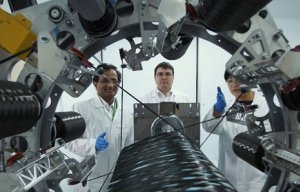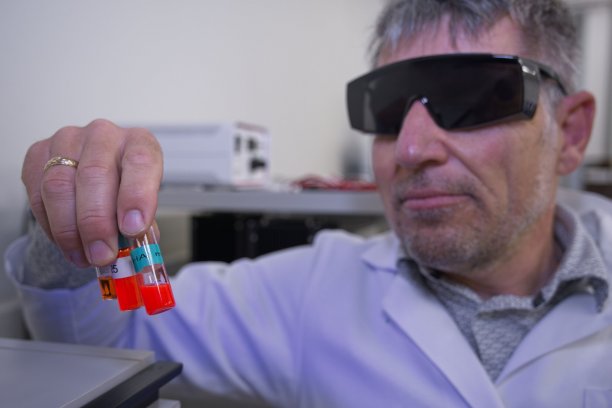
Nine-axis winding for faster carbon composites
Potential applications in organic solar panels, sensors, ultrafast data transmission and even medical diagnostics.

26th July 2021
Innovation in Textiles
|
Zurich, Switzerland
When fluorescent dye molecules nestle perfectly together, something completely new is created – an excited state distributed over many molecules.
Such collective excitations of fluorescent dye molecules have potential applications in, for example, organic solar panels, sensors, ultrafast data transmission and microscopy.
Researdchers at Empa, ETH Zurich, EPFL, the Paul Scherrer Institute (PSI) and IBM Research in Zurich have now succeeded in making such chemical light amplifiers ten times more efficient than before.
This is energy transfer that is much faster than in any semiconductor, according to Jakob Heier of Empa’s Functional Polymers lab.
“We are talking about islands of dye molecules with a perfect, internal structure called J-aggregates, which although they have been known for more than 80 years, have recently attracted renewed attention in research due to the special electronic inner life of these dye islands,” he said.
For a dye to glow, the molecule must first be activated with light. Optical brighteners in detergents, for example, absorb UV light and emit bluish (visible) light – which is why white garments shine so brightly in the UV light of a nightclub. The emitted light is lower in energy than the light used to activate the dye, because part of the energy is converted into vibrations, i.e. heat, in the dye molecule.
Energy antennas
The J-aggregates studied by Heier and Empa PhD student Surendra Anantharaman behave differently from individual dye molecules. In these molecular islands, the molecules are well ordered and very close together, much like matches in a box. In this constellation, the dye molecule does not have to glow, but can pass on its energy to a neighboring molecule.
Compared to classic semiconductors made of silicon though, there is a crucial difference – in a silicon semiconductor, such as a solar cell, the excitation energy is transported via charge carriers, such as electrons, which “hop” through the material. In J-aggregates, by contrast, the electrons only oscillate back and forth in the dye molecule and never leave it. Instead of electrons, only oscillations are transmitted – similar to transmitting and receiving antennas in the macroscopic world. J-aggregates can “transmit” energy on the smallest scale – extremely quickly and across hundreds of molecules.
High losses
The phenomenon of J-aggregates and their special energy transmission was first discovered in 1936 by Edwin E. Jelley in the US and Günter Scheibe in Germany, but up to now, about 95% of the radiated energy was lost and could not be transmitted.
Construction errors in the system were to blame. In reality, the molecules were not so perfectly aligned and whenever the energy pulse encountered one of these defects during its journey through the J-aggregate, the energy transport was interrupted. An ordinary molecular vibration terminated the transfer, a bit of heat was generated, and the game was over.
The Swiss researchers have now succeeded in developing a dye system in which up to 60% of the incoming light is re-emitted. This also means that up to 60% of the energy can be transmitted without loss – compared to just 5% previously.
The key to this success is the perfectly constructed dye islands created in a fine emulsion of water and hexylamine. This is a so-called bicontinuous emulsion, which means the droplets suspended in the outer liquid must not be distant from each other, but must have combined to form streak-like structures. Only then does the dye under investigation form the desired defect-free J-aggregates and can “send” the absorbed energy over long distances without loss.
The researchers have a long way to go before what they have now achieved in an emulsion can be made technically useful, but signal transmission through dyes could penetrate many areas of everyday life. It is possible, for example, to capture weak infrared light with the help of the dyes and convert it into digital signals with the help of quantum dots – an advantage for sensor technology and solar cells which are supposed to provide electricity even in very weak light. Because of their unique properties, J-aggregates also lend themselves to applications in quantum computers and optical data transmission.
Finally, the signal-conducting dye aggregates could become useful in diagnostics in living tissue – infrared light, or thermal radiation, penetrates deep into human tissue without damaging cells. J-aggregates could make this radiation visible and digitise it. This could greatly facilitate and improve the high-resolution microscope imaging of living tissue.

Business intelligence for the fibre, textiles and apparel industries: technologies, innovations, markets, investments, trade policy, sourcing, strategy...
Find out more